Place Finding
A Transdisciplinary Deep Dive
The Uncertainty of Place
A single word ran down the cover of the magazine: PLACE. In bold, all caps, followed by a definitive period. The word hovered over a double-spread aerial photograph of expansive, dark-green waves. Intrigued, I pulled the unsolicited magazine out of its clear plastic bag. Glossy photographs inside touted the marvels of the San Francisco Bay Area, from food to entertainment to the outdoors, interspersed with pictures of midcentury modern interiors in glistening homes. Then came the portraits of smiling realtors. It was a promotional brochure for an upscale real estate company.
In this region with its rampant gentrification and displacement, even as the creative community strives to reanimate the meaning of place, their trending terminology has been co-opted for the hottest local commodity. Place has been productized as lifestyle. I tossed the brochure into my recycling bin. But something continued to trouble me. This suave example of the selling of my adopted hometown touched something at the core of my life and my work as an artist: the uncertainty of place.
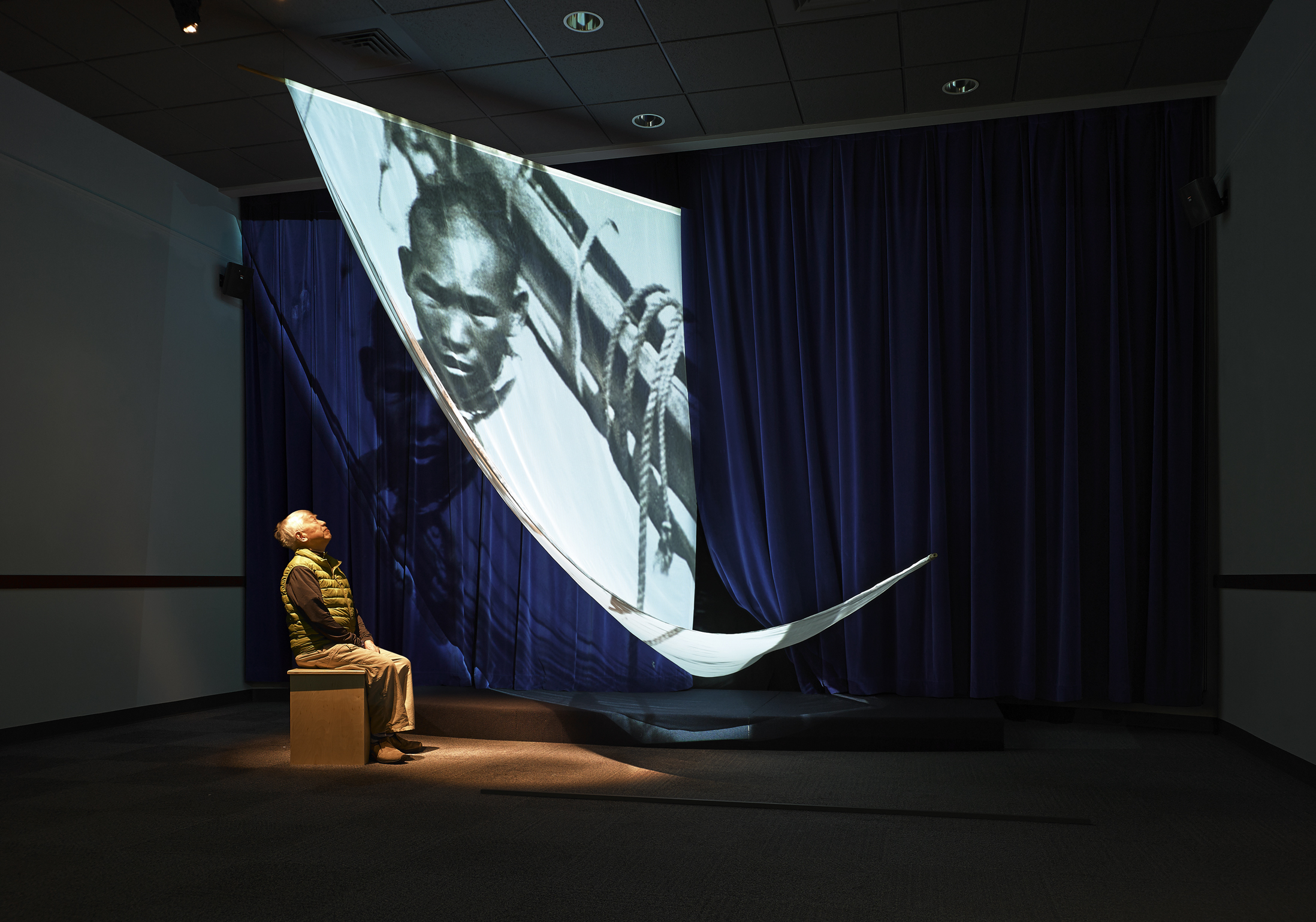
Chinese Whispers: Bay Chronicles (Phase 2) 2014. Immersive multimedia installation at the San Francisco Maritime National Historical Park, part of the National Park Service. The installation incorporated research and media from the Bay Chronicles voyage to create an environment that captured a visceral sense of being on the Bay in a wooden vessel, through spoken word, soundscape, interactive seating, and video projection. Here, a historical image of Chinese shrimpers is projected onto a translucent “sail” emerging from the institutional curtains of the park facilities. Photo Keith Baker
Whose Place?
As an immigrant from colonial Hong Kong, I have always had an ambiguous relationship to place. Growing up in the last major colony of the waning British Empire, I walked and lived on land that was owned by a foreign monarchy oceans away, and place felt at once intensely real and strangely abstract. By the stroke of history, the place I had known since birth, with its teeming streets, harbor, and building-encrusted hills, was not ours: technically, we were only sojourners on the very land that was part of our ancestral history. Tangible place was accessible only on temporary license decreed by historical treaties between Britain and China. Ours were the intangibles of place: sights, sounds, and tastes, a way of life and of being. They gave us the story of who we were, a way to locate ourselves on our existential map. When Britain finally “handed over” the colony to China, Hong Kong was yet again subaltern — this time to its mother country, its Western-influenced ideas a sharply monitored subject of contention. In this shifting geopolitical landscape, our stories were our home.
I learned my second lesson in the complexity of place when I came to the United States as an adolescent. You could say it was voluntary displacement — nobody made my parents send me six thousand miles across the Pacific to a country where I looked and sounded different from most of the population, in order to partake of the American Dream. But it was an uprooting, an unbelonging that shaped who I am. And what I carried with me were the intangibles of place: memory of sights, sounds, and tastes, of a way of life and of being. Presence and absence are flip sides of the same coin in the migrant’s journey of finding place and belonging. She comes to realize that place is embodied, that the place that is no longer at hand, outside, continues to live vividly inside.
This dislocated place is at once memory and reality, loss and liberation, fantasy and destination. Finding place is the journey of the dislocated, where arrival seems paradoxically to hover in the past or the future.
Seeking Place
It was inevitable that place and belonging became the center of my life work. Seeking more than financial security, I left a successful graphic communications business to explore the spatial poetics of installation art. Inspired by the ideals of community cultural development, I dove into socially engaged art, through intergenerational work with the frail elderly and youth from diasporic communities. Among these marginalized individuals, my migrant’s attunement to the nuances of displacement and un/belonging facilitated trust and engagement, as we worked together to bring their stories out into shared space. And with a designer’s interest in the potential of art to create spatial narratives in the built environment, I delved into public art. Then I began to mash up installations, community cultural development, and public art.
The mash-up, too, was inevitable. For an artist inhabiting hybrid spaces, working with populations trying to find their place in the shifting interstices of society, the only honest language is what Trinh Minh-ha called the necessary, “radical ‘impurity’” of speaking from a hybrid place, to “[say] at least two, three things at a time.”
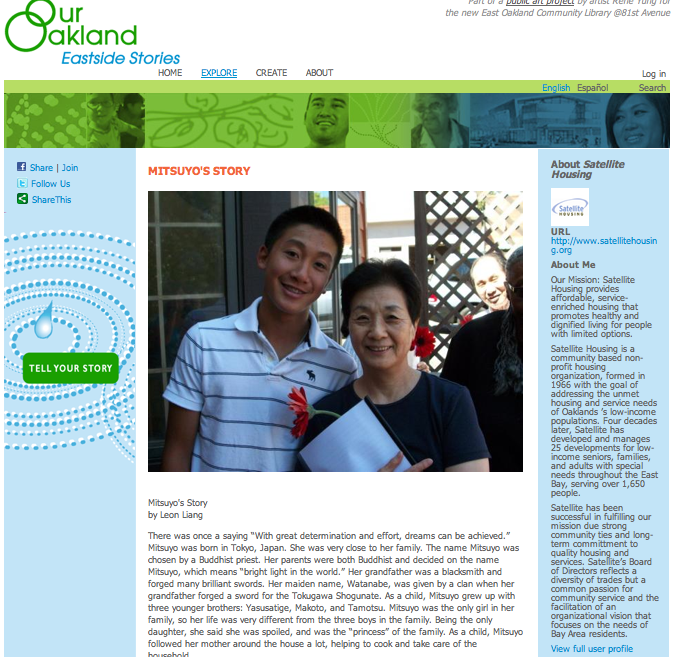
Our Oakland: East Side Stories (2006–11). A view of one of the stories on OurOakland.org, a storytelling website featuring community stories about East Oakland that formed part of the public art elements for the 81st Avenue East Oakland Community Library in Oakland. This story, “The Perez Family,” was produced by Youth UpRising, one of the project’s Community Media Partners, and told the story of the immigrant family’s experiences of East Oakland, and their dreams for the future of their family. Photo Rene Yung Communications Design
Our Oakland: Eastside Stories
In 2006, I leveraged a public art commission for the Eighty-First Avenue East Oakland Community Library to integrate community engagement as a coeval part of the artwork. The public knew of East Oakland, California, mostly through sensational, negative media portrayals that diminish the community’s humanity and diversity. As a trusted civic institution for public knowledge, the library provided a perfect context for the community to counter their marginalization by taking back their story.
With full support from the community and the project team — the library, Art Commission, and project architects — Our Oakland: Eastside Stories rolled out in three interlinked parts aimed at giving voice to East Oakland as a place and a community: OurOakland, a storytelling website featuring stories by diverse East Oaklanders about East Oakland; a collaborative community-building program that included Community Storytelling Days teaming together schools, families, local community-based organizations (CBOs), and media producers to gather community stories while providing family enrichment activities such as nutritional education and art making; and architectural enrichment featuring a sixty-four-foot span of glass art and an interactive “Story Pod” dedicated to the OurOakland website. I secured additional, multiyear foundation funding and did personal fundraising for the public engagement portion of the project.
OurOakland.org launched in 2011 with 101 community stories and a celebratory community convening that brought together community members, CBO partners, and government representatives. Upon completing my public art commission, I handed the project over to the Oakland Public Library, together with a technical manual and community engagement briefing for library staff. However, due to staffing shortages, the library was unable to maintain the story-sharing program, and less than two years later, during the library’s web-hosting change, the website was inadvertently and permanently “lost.”
Lessons Learned and Questions Raised
Through strategic thinking, it is possible to find ways to navigate the institutional system in order to innovate community-engaged public art, but innovation cannot be sustained without adequate infrastructure over the long term. Beyond vision and enthusiasm, real social change requires time, money, and supportive cultural policy.
The hardest part about the unexpected project trajectory for me was feeling that I let down the community, who trusted me and the project with their stories, and gained pride from their telling — and who placed hope on art and the artwork as a vehicle for their voices to be heard. Long after the website disappeared into cyberspace, community members with whom I had built rapport would reach out to me, hoping to find an outlet for another story or concern.
What, then, are the ethics of well-intentioned community-engaged art when the shared goals and the needs of the project community cannot be realized without adequate long-term support? Is it viable to try to embed significant social engagement in the existing public art structure? What avenues are available to the artist to effect deep social change in the big picture, and in what form and with what kind of support? These questions nagged at me as I pondered my lessons learned, and they catapulted the next phase of my work.
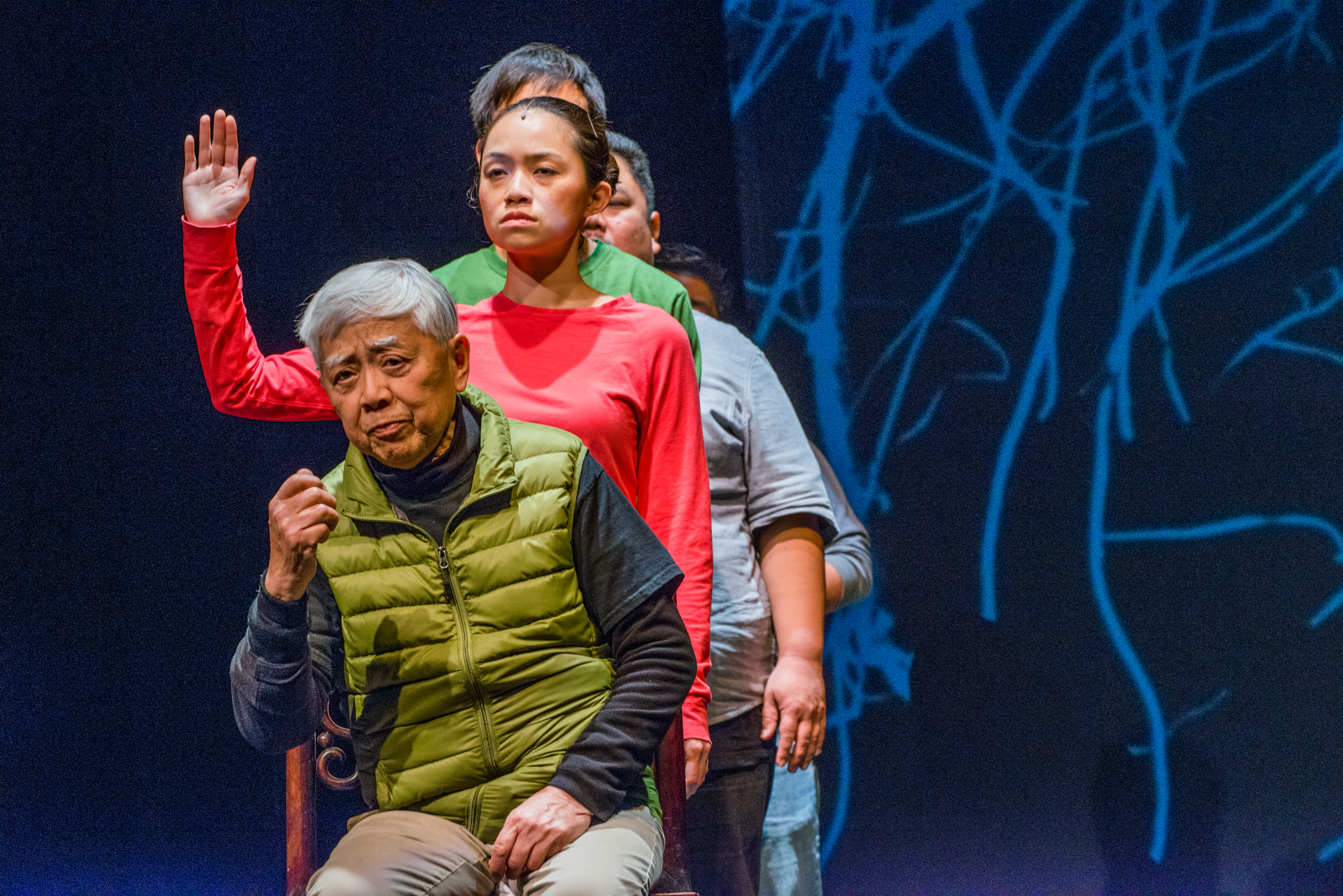
Chinese Whispers: Golden Gate, 2010–16. A scene from the multimedia storytelling theater work connecting historical and present-day stories from Chinese immigrant communities in the San Francisco Bay Area. In this scene, community performers recount personal stories about the legacy of the Chinese Exclusion Act. Photo Pat Mazzera Photography
Finding Place
Presence Out of Absence
While working on OurOakland, I was commissioned to create an installation in Sun Valley, Idaho, about the “vanished” Chinese railroad and mine workers who lived in the area in the nineteenth century. As an immigrant, I actually knew very little about the history of the early Chinese in America. The poignancy of their hazily recorded presence, and subsequent absence, struck me deeply as I did research for my installation. I made an interactive piece about erasure, where visitors used bars of soap imprinted with the word “REMEMBER” to wash towels imprinted with words of memory and identity — over the course of the exhibition, the words on both the soap and the towels were worn away. Taking part in that act of symbolic erasure often opened up visitors, who would then recount bits of anecdotes they had heard about the Chinese in remote Western and Intermountain places. It was as if the installation gave them a way to disburden themselves of a historical complicity, by sharing the memory of these anonymous individuals who had been banished to the hinterland in local narratives. But the dominant cultural ambivalence about these acts of erasure was summarized by one of the anecdote sharers: when asked what happened to the Chinese, he shrugged and said, “They went away.”
That statement and the handful of stories spurred me on to research the forgotten history of the Chinese in the building of the Transcontinental Railroad and of the American West. At that time, the subject was largely ignored, both by mainstream history and the Chinese American community. Scholars I consulted scoffed at my interest because of the dearth of known, surviving primary source materials; only apocryphal snippets remained, I was told. But it was the silence that called to me.
This very absence became both metaphor and structure for what would be my next creative endeavor, as I learned about the pervasive pattern of erasure in the history of the Chinese in the American West. The erasure was geographic, cultural, legal, and often violent, taking place amid the anti-Chinese movement of the nineteenth and early twentieth centuries. And the erasure scrubbed across the nation’s collective memory. For the first time, as an immigrant with my heart still anchored on the other side of the Pacific, I began to truly connect with the history of the diasporic Chinese American community from more than 150 years ago, whose subculture had felt very different from mine at first brush. Something clicked into place between the colonial erasure in my birthplace and erasure in the American landscape where I now live.
The gaps in recorded memory and the enormity of the geographical and historical scale were both daunting and inspiring. But absence also holds the transformative potential for presence. The displacement in those handed-down story fragments that I heard in Idaho sparked not only my indignation and curiosity but also my imagination. Born out of this mixture of absence and promise, Chinese Whispers was initially conceived as a series of community-engaged, place-based storytelling works that would unfold across the spatial and historical terrain of the West.1 The name is an ironic critique of its use as another term for the game of “Telephone,” where the garbled unintelligibility of successively passed-down phrases becomes racialized entertainment. It is also a poetic elegy to the tenuous words passed down through time and across space to thread together the story of the early Chinese in this country.
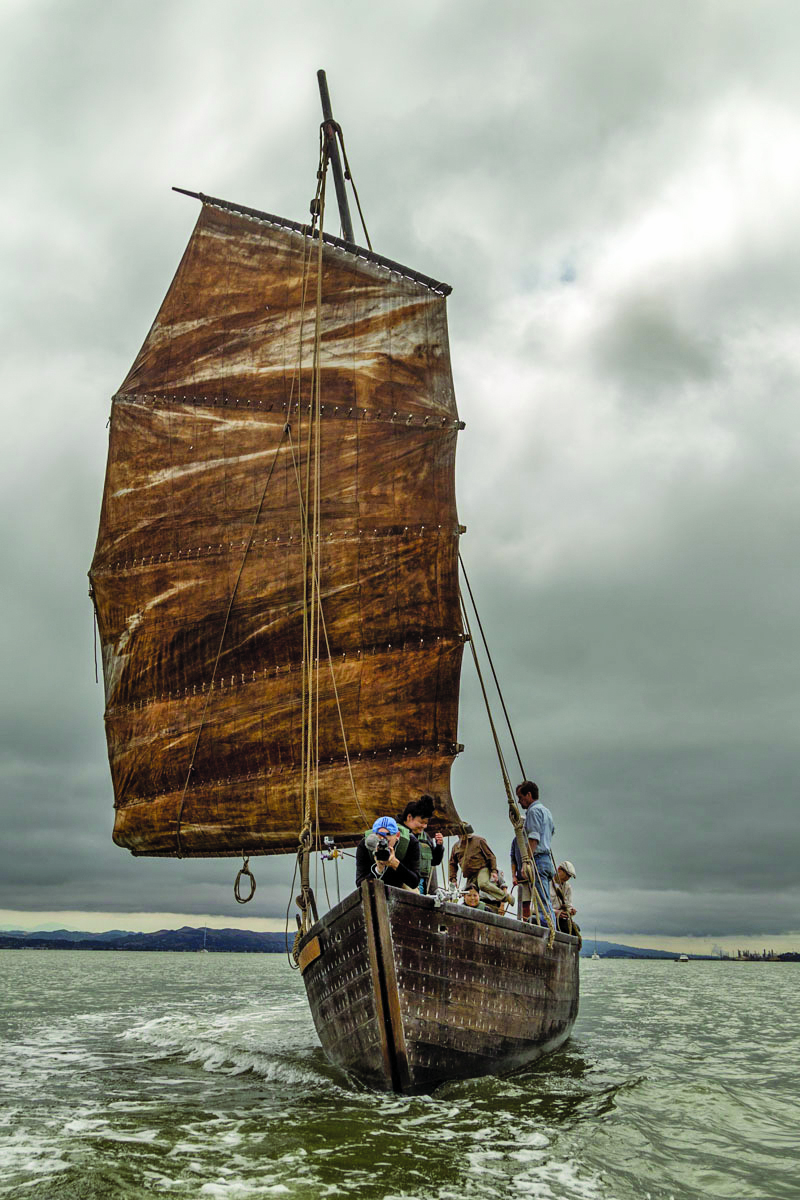
Chinese Whispers: Bay Chronicles (Phase 1), 2013–14. A research and chronicling expedition on a replica nineteenth-century Bay junk to retrace the forgotten history of Chinese shrimp fishing on San Francisco Bay, with an interdisciplinary team of artists, scientists, historians, and sailors. Site-specific community programming took place at key landing sites during the two-week sail to six different former shrimping sites. Photo Jeff Lee
Story and Place
The project launched with the pilot, Chinese Whispers: Sierra Stories (2006–09), focusing on the Sierra Nevada foothills. I interviewed nearly eighty people in the region for personal memories and handed-down stories and wove these fragmentary pieces together into a porous tapestry of excavated memories. A multimedia production of Sierra Stories was presented at the Tower Theater in Roseville, near Sacramento, California, in 2009, with a cross-generational, cross-cultural cast of community members that included many of the story contributors, who told their own stories on stage. Rather than trying to “make whole” a history of rupture, the nonlinear work juxtaposed absence and presence across places and time, and the audience got it — they understood not only the historical erasure of the Chinese in their foothills community but its resonance across cultures and its relevance today across America.
The post-performance audience discussion was an inspiring object lesson in the public understanding of how place is socially constructed. It also reinforced something that dawned on me as I searched out historical sites in the foothills where the early Chinese had been: amid the Sierra Nevada’s powerful sense of place, the absence today of the Chinese in the very places where their stories once unfolded was palpable and eerie for the informed, yet unnoticed by the general public, who is unaware of this legacy. Deprived of their story, people are also deprived of their place, whether on the map or in history. In spite of the specifics that my interviewees talked about — sharecropped fields, family restaurant, arson-destroyed store — what they did not know about their forebears in America infused their stories with a sense of deep longing that can best be described as a spiritual loss of place from a century and a half of erasure. The process of uncovering hidden private memories and surfacing them into public narrative was a way to resuscitate and reconstruct some of the lost sociocultural space. It was a way to find a place in the larger sphere of the collective memory, where belonging can take root.
A Transdisciplinary Approach
As I considered my next steps in this journey of place finding, I found continued challenges to my increasingly hybrid arts practice. Different parties raised different objections: “But is it Art?” “What kind of theater is that?” “Is this art or humanities?” As well, the fluid range of media and disciplines I was working in did not fit neatly into funding categories. But these challenges served to crystalize the vision that grew out of my hybrid reality for giving voice to other hybrid stories. Business innovator Beth Comstock describes risk taking as the willingness to take action on imagination. That is one asset that artists have in abundance. I banked on imagination and fleshed out my model as I brought Chinese Whispers to the Bay Area.
To address the project’s complex relationships across geographical and historical space, I developed a system of place-based inquiries that share an overarching vision and methodology built on research, public engagement, and artistic innovation. In-depth research across disciplines, including history, archaeology, geography, science, and oral testimony, provides crucial context for understanding each inquiry from multiple perspectives, which in turn give the projects fresh relevance. Authentic community engagement forges indispensable networks for finding hidden stories and fostering their stewardship, as well as builds a strong audience base. Thematic public programs at iconic sites, for example, onboard the three-masted sailing ship Balclutha, where Chinese workers had toiled in the cannery trade, create memorable experiences for the audience by juxtaposing storytelling with literary and informational presentations that bring history to life. And shaped by the research and stories, each inquiry takes an artistic form that is most compelling for inspiring audience imagination and informing public understanding. Besides storytelling theater work, these expressions have ranged from a sailing expedition to multimedia installations.
A network of collaborations and partnerships makes this expansive scope feasible with our fledgling resources, as Chinese Whispers developed from a personal vision out into the community. The cross-sector, cross-cultural sharing enriches each partner and helps bring this overlooked history to broader audiences. Collaborators include such diverse partners as the National Park Service, the Chinatown YMCA, and the Stanford Archaeology Center, as well as historical societies, biologists, ecologists, and media, literary, and theater artists.
Reaching across sectors and communities, the transdisciplinary approach brings about a dynamic, multifaceted whole that transcends the sum of its parts.
Case Studies
In the nine years following Sierra Stories, Chinese Whispers unfolded in four large-scale projects and related artworks. Ranging across spaces from the San Francisco Bay to cyberspace, they are unified by their mission to give voice to hidden stories and reclaim them from historical amnesia in the evolving story of place in America today.
Golden Gate (2010–16), the flagship Chinese Whispers multimedia storytelling theater work, connected handed-down stories about the early Chinese in the Bay Area with the experiences of immigrants in San Francisco Chinatown today. Through a multiyear community engagement process that included oral history interviews and intergenerational storytelling workshops with immigrants from the Chinatown YMCA, the project built deep relationships with both individuals and organizations in the community and captured the memories of important community elders, who have since passed on. Cast members were immigrants themselves or multigenerational descendants of immigrants, including an eighty-four-year-old community stakeholder who told his own stories on stage. They received performance training, which further empowered them as stewards of these community stories.
Mapping the Traces (2010–12) piloted a mapping website to visualize the historical presence and erasure of the Chinese in the American West and literally put their geo-located stories back on the map, along with interpretive texts by knowledge experts.
Bay Chronicles (2013–16) uncovered the then little-known story of the once-thriving Chinese shrimping industry on San Francisco Bay. It retraced this forgotten history through a research and chronicling expedition on a replica nineteenth-century Chinese shrimp junk to former shrimping sites on the Bay. Site-specific public programs at major landing sites stirred the public’s imagination and opened up fresh interest in the history, renewing civic dialogue around it. The project culminated in an immersive multimedia installation at the San Francisco Maritime National Historical Park, part of the National Park Service. It featured media recorded during the sailing expedition and a layered soundtrack that included historical texts and the voice of the last resident of the only remaining former shrimping site at China Camp in Marin County, north of San Francisco.
Written on Water (2017, ongoing) developed out of Bay Chronicles to further transdisciplinary research on the history of the Chinese fishery on San Francisco Bay, and connect the intersecting histories of displacement of the migrant Chinese fishing community and habitat loss on the Bay margins, where they lived and fished. To date, the project has taken form as a series of mixed-media artist books, nonfiction writings, and in conjunction with my Urban Fellowship at the Fisher Bay Observatory of the Exploratorium, public programming that brought together historical and scientific perspectives enlivened by storytelling.
I also collaborated with the Stanford Archaeology Center, the San Jose Institute of Contemporary Art, and local history organizations, to reinterpret archaeological artifacts from the former site of the San Jose Market Street Chinatown, which was destroyed by arson fire during the anti-Chinese movement. City Beneath the City, a trilogy of site-specific installations, reframed the artifacts as micro-stories about the people who lived in the Chinatown and its destruction, rather than as academic objects. The installation brought the overlooked history to the front page of the San Jose Mercury News, the major local newspaper, for the first time.
The projects were primarily grant funded, with additional support from fundraising efforts, immeasurable amounts of dedication, and belief in the work.
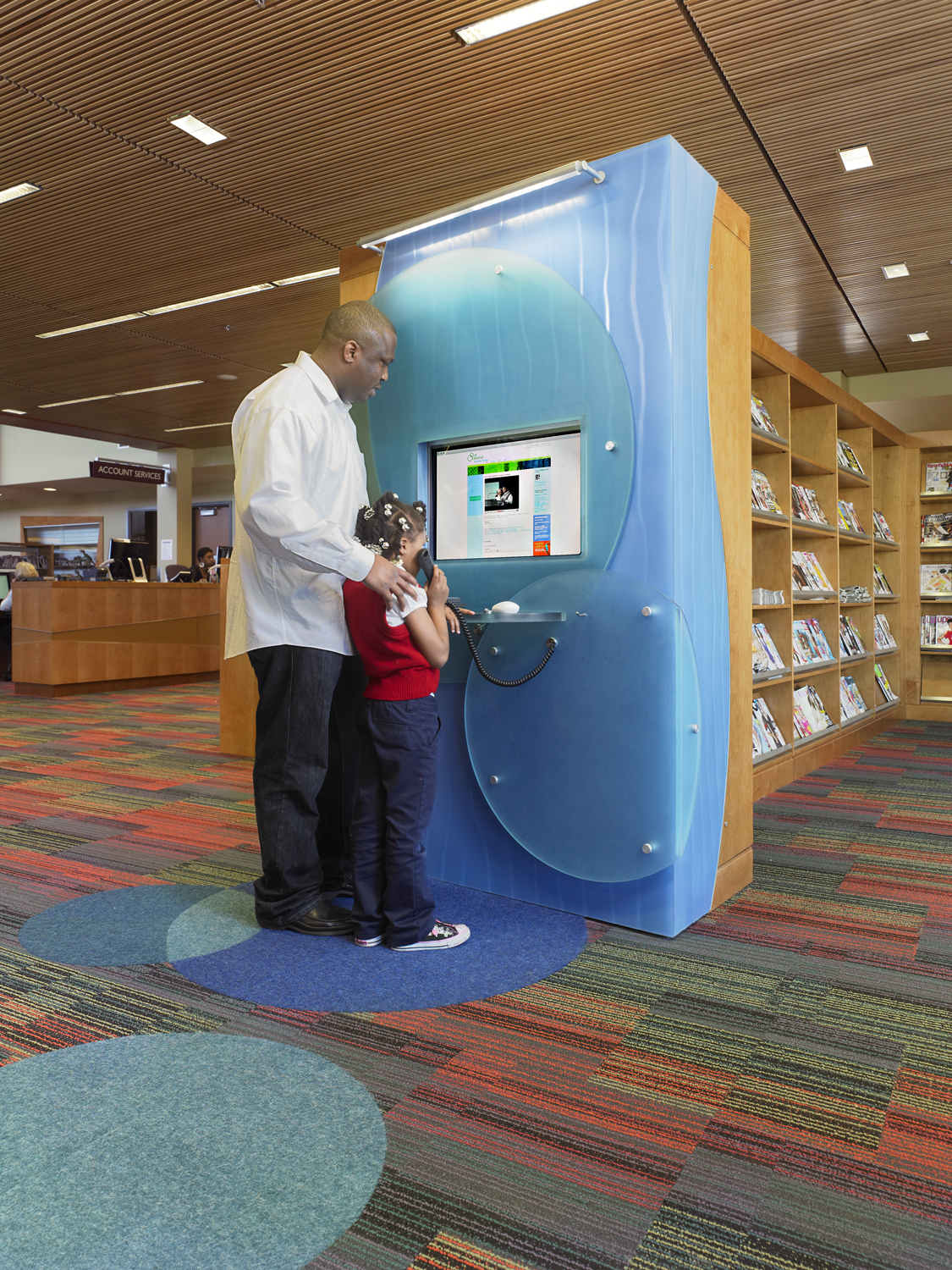
Our Oakland: East Side Stories (2006–11). Community members at the “Interactive Pod,” one of the public art elements for the 81st Avenue East Oakland Community Library in Oakland. The “Pod” featured the OurOakland storytelling website with community stories about East Oakland. Photo Keith Baker
Conclusion
For communities that have been historically erased from the public narrative, and for migrant communities, place is complex and contradictory, where absence haunts presence. For them, finding place is part of finding self and belonging.
For descendant communities, the erasure of their immigrant ancestors from the American narrative and public memory runs like a scar of injustice across the present landscape. For the migrant community today, memories and connections to the places left behind and efforts to find their place in America coexist in shifting geographies of belonging and loss. When these private memories become public testimonial, they water the seeds lying dormant within absence, so it can begin to transform into presence and so that place can shed some of its burden of social and cultural hegemony.
Rather than sentimental romanticizing of a lost past, I see my work as forensics, a process of uncovering and making visible and heard, and connecting the dots to reveal unexpected relationships in a step toward social and cultural justice. Transdisciplinary art provides the dynamic versatility for engaging with the many variables of erasure to resuscitate forgotten or suppressed voices. Related projects inform each other to reveal and articulate the big picture. This integrated approach provides a framework for place finding that anchors past and present in each other. And in the process of engaging community in place finding, I began to find place for my migrant self.
Rene Yung is an artist, writer, designer, and cultural activist who helps communities and nonprofit organizations uncover overlooked histories and connect them to today’s places with new relevance. A native of Hong Kong now living in San Francisco, she is an Urban Fellow of the Fisher Bay Observatory at the Exploratorium, and the founding director of the nonprofit organization Chinese Whispers, which uses a transdisciplinary blend of research, cultural production, and public engagement to shine light on the overlooked history of the Chinese in the American West. She has collaborated with and consulted for numerous institutions, including the Institute on Aging, the Stanford Archaeology Center, the Museum of Chinese in the Americas, and the Wing Luke Asian Museum, and has exhibited at international and national venues, including TransCulture, part of the forty-sixth Venice Biennale; the Contemporary Art Museum, Houston; and San Jose Museum of Art.
NOTE
- These storytelling works turned Chinese Whispers into a nonprofit organization that, according to the website, “brings to light the overlooked history and experiences of the Chinese who helped to build the American West.”
